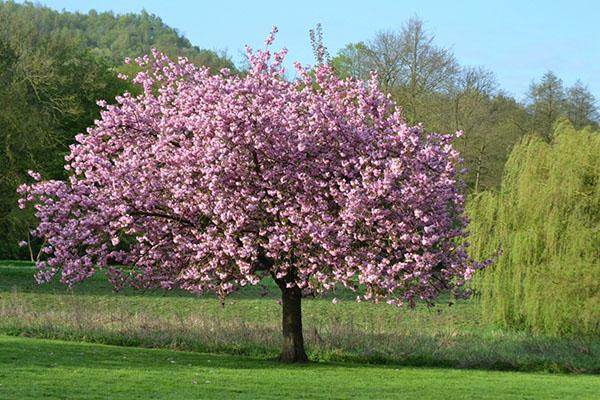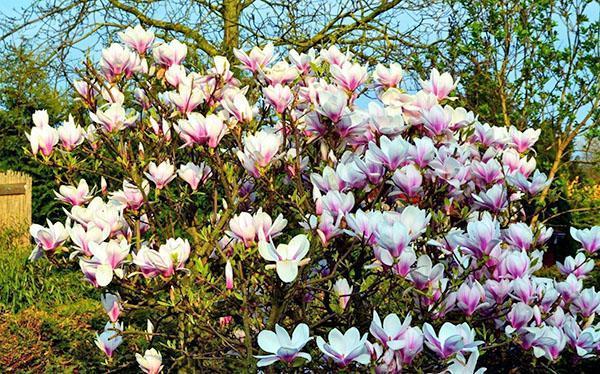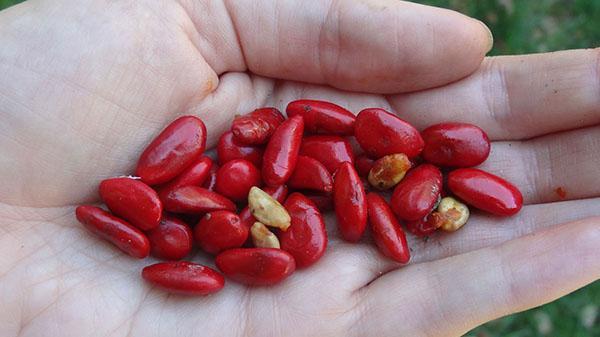A new touch in landscape design - growing magnolia in the garden
 To admire the beauty of this amazing plant, you don't have to live by the sea. Growing magnolias in the garden is quite possible. Saplings of different varieties successfully take root in many regions, grow in partial shade and are able to endure winter cold without loss.
To admire the beauty of this amazing plant, you don't have to live by the sea. Growing magnolias in the garden is quite possible. Saplings of different varieties successfully take root in many regions, grow in partial shade and are able to endure winter cold without loss.
The scent of this flower has a beneficial effect on the nervous system, soothes and relieves stress.
But if you stay too long where magnolias grow, your head can hurt. The aroma of this plant is used by world perfume brands (Kenzo, Yves Rocher, Aqua di Parma).
Description and types

Species diversity and frost resistance
The most resistant varieties: Kobus, Zibolda, large-leaved, large-flowered, willow, Lebner.
Less resistant varieties: umbellate, white, nude, Sulange, lily.
In Siberia, you can also plant and care for magnolia. In this case, varieties are selected that can withstand the cold well.
Growing magnolia from seed in a garden
 To date, it is not a problem to acquire the seed of this culture. For cultivation in the suburbs, they most often buy Siebold's magnolia. As a rule, the grains are covered with a protective shell (sarcotesta). Beneath it there will be another layer in the form of a white oily substance. It protects seeds from early germination. All these shells must be removed before planting. Rinse the seeds themselves well with clean running water. The next step is to subject it to cold hardening (stratification).
To date, it is not a problem to acquire the seed of this culture. For cultivation in the suburbs, they most often buy Siebold's magnolia. As a rule, the grains are covered with a protective shell (sarcotesta). Beneath it there will be another layer in the form of a white oily substance. It protects seeds from early germination. All these shells must be removed before planting. Rinse the seeds themselves well with clean running water. The next step is to subject it to cold hardening (stratification).
Some gardeners sow frost-hardy magnolia seeds in the fall directly into open soil, covering them with leaves.
Wrap the grains in slightly moistened moss and leave them in the refrigerator on the bottom shelf for about 3-5 months. The most suitable temperature is 0 °. If it is lower, seeds and shoots may die. Check the material once a week. As soon as the grains germinate, plant in containers. Take a sufficiently deep pot (about 40 cm), fill it with fertile soil with peat.
Growing magnolias in the garden requires soil monitoring. Souring of the soil is unacceptable; it must be well-drained to allow air to pass to the roots. Lay out the bottom of the pot with a 10 cm layer of expanded clay drainage. Soak sprouted seeds in a stimulant solution (as indicated in the instructions). Bury each grain in moist soil about 2 cm. Place the container in a warm place with plenty of bright, diffused light. If the air is very dry, take care of the greenhouse. After the emergence of seedlings, the conditions of detention remain the same. When two pairs of leaves are formed, water with a weakly concentrated solution of fertilizer for seedlings.
Planting magnolias is best done in the fall when young seedlings stop growing. Depending on the region, sometime in early or mid-October.That is, when there is no frost yet, but it is no longer hot outside.
Hardening and fit
 When the spring frosts pass, the pots can be put outside in partial shade. At night, it is still necessary to bring them into the room. As soon as a stable, even positive temperature is established at night, containers with magnolia can no longer be brought in, but, for example, dug in the garden.
When the spring frosts pass, the pots can be put outside in partial shade. At night, it is still necessary to bring them into the room. As soon as a stable, even positive temperature is established at night, containers with magnolia can no longer be brought in, but, for example, dug in the garden.
Seedlings - first years should winter indoors. You can store them in the cellar. The main thing is that they do not freeze. The conditions of detention will remain the same for the next year.
In the spring, take out a magnolia seedling into the garden, regularly water and fertilize from mineral fertilizers... But in the third year, you can safely transplant your magnolia into open ground. First, it has already passed the hardening period. Secondly, when transplanting on the roots, it is imperative to preserve an earthen lump. Thus, the plant will experience less stress and the roots will be protected from damage. But before planting a magnolia, you need to choose the right site. The place should be sunny, protected from northerly and easterly winds. In the south, where the sun is especially hot, partial shade is acceptable.
Cuttings are also used to propagate magnolias. They are cut from young specimens towards the end of July. At the top, 2 - 3 leaves must be left, and the cut is treated with a root formation stimulator.
The stalk is planted in a container with sand, covered and kept at a temperature of 19 - 22 degrees for 5 to 8 weeks. Cuttings are planted in open ground no earlier than a year later. If you decide to place it immediately in the garden, take care of a good shelter.
Soil and watering
 Magnolia soil should be light, slightly acidic, fertile. Also a prerequisite for the ground is that it must pass air well. In addition, moisture in the area should not stagnate. Heavy, long-drying soil, not the best option for growing magnolias in the garden. The pit should be about three times the size of the root system in volume. Pour rubble and broken branches to the bottom as drainage. Lay out fertile soil on top (you can mix it with rotted manure and small coniferous bark).
Magnolia soil should be light, slightly acidic, fertile. Also a prerequisite for the ground is that it must pass air well. In addition, moisture in the area should not stagnate. Heavy, long-drying soil, not the best option for growing magnolias in the garden. The pit should be about three times the size of the root system in volume. Pour rubble and broken branches to the bottom as drainage. Lay out fertile soil on top (you can mix it with rotted manure and small coniferous bark).
Planting and caring for magnolia in the Moscow region is no different from other regions. The main thing is to protect the roots.
Therefore, the top layer of the earth is not recommended to be strongly compacted. Be sure to spend mulching coniferous bark. This will make it easier to maintain the necessary moisture and acidity of the soil. If new leaves and shoots appear, then everything is done correctly, and the plant has taken root.
Water the magnolia regularly with warm, soft water during hot weather. Do not allow the earth to dry out or waterlogged.
Top dressing and other secrets
 You can achieve lush flowering from a plant if you follow certain rules:
You can achieve lush flowering from a plant if you follow certain rules:
- For stable growth and beautiful flowering, fertilizers are needed. The first feeding of magnolias is done in the spring. In order for the plant to bloom beautifully, it is better to add mineral compositions with a high nitrogen content to the soil (excellent growth stimulation). When buds are tied and during flowering, it is better to use special complexes designed for flowering plants. Calculate dosages strictly according to the instructions. July is the time of the last feeding. From the end of August, magnolias gradually enter a dormant period and prepare for wintering. Any stimulation of growth at this time is contraindicated.
- The bottom of the trunk and roots must be covered for the winter. To do this, use a special cloth, straw or spruce branches.
- Care must be taken with transplants. The superficial root system is very easy to damage. Therefore, if you can see that the tree is good in the selected area, you do not need to transfer it anywhere.
- It is believed that the crop is resistant to diseases and pests. But for prevention, it is still worth periodically treating with special biological products.
- Planting and caring for magnolia outdoors includes pruning.But this should be done only when necessary: for example, if there are branches crossed inside the crown. They need to be cut. This procedure will improve growth and decorativeness. Remove dry branches and frozen buds after flowering. All sections must be processed with garden pitch. Cut magnolias shrubs to give them a compact and beautiful shape.
Don't be afraid to experiment. Create favorable conditions in your garden and you will definitely make friends with this exotic beauty.